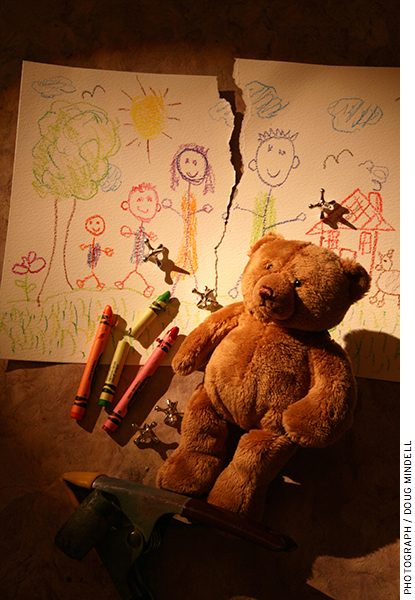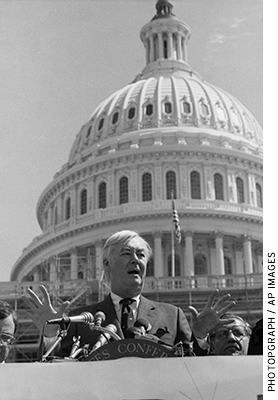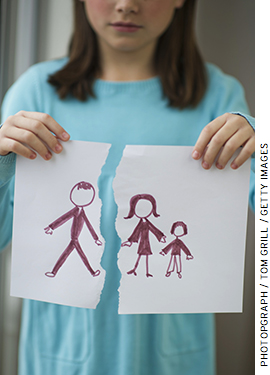This article is part of a new Education Next series on the state of the American family. The full series will appear in our Spring 2015 issue to mark the 50th anniversary of the 1965 release of Daniel Patrick Moynihan’s report “The Negro Family: The Case for National Action” (generally referred to as the Moynihan Report).
 As a general rule, assistant secretaries in the Labor Department do not produce lasting historical documents. The so-called Moynihan Report, produced by Assistant Secretary Daniel Patrick Moynihan in the winter of 1965 and published under the title “The Negro Family: The Case for National Action,” is surely the only exception to that rule. But it is quite an exception.
As a general rule, assistant secretaries in the Labor Department do not produce lasting historical documents. The so-called Moynihan Report, produced by Assistant Secretary Daniel Patrick Moynihan in the winter of 1965 and published under the title “The Negro Family: The Case for National Action,” is surely the only exception to that rule. But it is quite an exception.
The Moynihan Report gained notice and notoriety almost immediately. Its statistical analysis was cited, and its call to action was repeated, by President Lyndon Johnson within a few months of its publication—again, an uncommon fate for a Labor Department report. But its analysis was just as quickly resisted and disputed in the government and in the academy. Moynihan was accused of arguing that low-income black families were simply causing their own problems and of trying to undermine the civil rights movement. The social psychologist William Ryan actually coined the now-common phrase “blaming the victim” (which he used as a title for a 1971 book) specifically to describe the Moynihan Report.
Of course, Moynihan did no such thing. To the extent that he attributed blame at all, it was to the long and ugly legacy of slavery and to the persistence of racism in American life. Both, he argued, had worked to undermine the standing of black men, and thereby their roles in their own families, and to deform the structure of family life in the black community.
But Moynihan’s aim was in any case less to assign blame than to describe a peculiar problem. The problem first presented itself to Moynihan and his team in the form of a surprising divergence in the black community between unemployment rates and welfare application rates (which coincided with rates of single motherhood, since essentially only unmarried mothers could apply for the Aid to Families with Dependent Children program). Until the late 1950s, the two indexes had risen and fallen together. But starting in the late ’50s, welfare rolls increased even when unemployment was low and the economy was strong.
Moynihan came to understand that he was seeing something new and deeply troubling. Most impressive in retrospect is that he understood that this emerging pattern was troubling above all not for economic reasons, but for deeper and more significant reasons—reasons that are ultimately cultural. “The fundamental problem,” he wrote, “is that of family structure. The evidence—not final, but powerfully persuasive—is that the Negro family in the urban ghettos is crumbling.” Communities affected, he worried, faced “massive deterioration of the fabric of society and its institutions.” Such deterioration, should it prove in fact to be occurring, would constitute “the single most important social fact of the United States today.”
In the decades since Moynihan wrote those words, his work has been held up as an example of prophetic social science, and of constructive policy analysis. And his case has served as the foundation for efforts to focus attention and resources on strengthening family formation among the poor. But both the controversy surrounding the report and the continued attention devoted to it have acted to obscure somewhat the key achievement of Moynihan’s work and so, too, its foremost lesson for our own time.

The strength of the report was not in its analysis of the causes underlying the collapse of the family among lower-income African Americans. Moynihan was convinced that what he was witnessing was fundamentally a phenomenon of the black community, and so could be explained by the tragic history of African Americans, which rendered black families uniquely vulnerable to the kind of social and economic pressures many faced in poor urban environments.
There is of course no question that the savage inhumanity to which African Americans were subjected in our country for much of its history and the racism that has persisted far longer have had detrimental effects on the black community and on its families. But the particular pattern Moynihan began to observe in the 1960s has not in fact been limited to the black community. In the half century since he wrote, the pattern has shown itself in the lives of poor Americans of all races. The problems remain worst in the black community, and the history and realities of racism that Moynihan pointed to are surely important contributing factors, but the challenge of family disintegration plainly runs deeper and broader than that. Family breakdown appears to be a prevailing feature of modern American poverty. In this sense, Moynihan’s analysis of causes was not quite on target.
Focus on the Problem
The report is also notable for not proposing solutions to the disturbing set of problems it laid out, although the author did suggest policy prescriptions elsewhere. Indeed, Moynihan specifically committed the report to stick to diagnosis. “The object of this study has been to define a problem, rather than propose solutions to it,” he wrote. And the chief reason for doing so, he argued, was that “there are many persons, within and without the Government, who do not feel the problem exists, at least in any serious degree. These persons feel that, with the legal obstacles to assimilation out of the way, matters will take care of themselves in the normal course of events.”
And here we find the true core of Moynihan’s contribution. It was, simply put, to tell the truth, both about what emerging facts seemed to suggest about a troubling social trend and about the foreseeable implications of that trend for the lives of the people involved. The family appeared to be breaking down among lower-income black Americans, and to Moynihan broken families meant broken communities and broken lives. Both elements of that diagnosis were crucial, and both were hard pills to swallow.
The latter element in particular—the importance of the family to the health and flourishing of society—has been controversial in the half century that followed Moynihan’s report. Roughly halfway through that period, in 1992, Moynihan himself took up that controversy in a speech delivered at the University of Chicago (and later reprinted in the Public Interest). He was blunt. Despite President Johnson’s personal interest in his arguments, Moynihan said, the years that immediately followed his report—the era of the Great Society—brought an approach to social science and to public policy that made the problem he had diagnosed much more difficult to address effectively, and even to talk about honestly. Simply put, he said, the Great Society era “gave great influence in social policy to viewpoints that rejected the proposition that family structure might be a social issue.”
That was an understatement. The most striking, even shocking, feature of the sociological (and to some degree economic) literature in the several decades following Moynihan’s report is the sheer lack of interest in the question of what the breakdown of the family among the poor, which no one could deny was occurring, might mean in the lives of those involved. The few exceptions acted merely to prove the rule.
Those exceptions included the work of Moynihan himself during his academic career; most of the other people responsible for exceptional attention to this problem followed a path similar to his. “Think, for example, of the writing in the early editions of the Public Interest,” Moynihan noted in that 1992 lecture. “Almost without exception, the authors were political liberals who had stumbled upon things that weren’t entirely pleasing to them but which, as the song goes, could not be denied.” Many people, of course, did deny them. But ultimately, Moynihan suggested, facts were facts and their consequences could not help but follow.

from 1993 to 1995.
When he delivered the lecture, reflecting on his report some 27 years after its publication, Moynihan might have had some reason to suppose that his small band of truth tellers was finally getting heard. In retrospect, those early years of the 1990s seem like they might have been the apex of that band’s influence and stature in the public square. Moynihan was chairman of the powerful Senate Finance Committee, with jurisdiction over welfare and entitlement policy, among much else. James Q. Wilson and James S. Coleman, both members of that original Public Interest circle, were, respectively, president of the American Political Science Association and president of the American Sociological Association. The Democratic Party’s nominee for president in 1992 spoke about family breakdown and welfare in terms that even some Republicans had not always been comfortable with. And the academic wall of silence seemed to be cracking just a little, perhaps especially after William Julius Wilson’s The Truly Disadvantaged (1987) was released and sociologists Sara McLanahan and Gary Sandefur’s book Growing Up with a Single Parent (1994) powerfully documented the detrimental effects of family breakdown on children. It could well have appeared as though the tide was finally turning, and the vital importance of family structure would finally find its place in public policy and the public debate. Moynihan, in that moment, seemed almost optimistic.
But it was not to be. Family structure would remain off-limits, even as the underlying trends evolved to encompass more of the populace. Since the early 1990s, the fact that births out of wedlock are not fundamentally a matter of race has become far clearer. In 2010, 72 percent of African American births were to unwed mothers, but so were 53 percent of Hispanic births and 36 percent of white births—all far higher figures than those Moynihan saw in the black community in 1965, when he described a 25 percent rate as a social disaster. In our nation as a whole, 41 percent of children born in 2010 were born to unmarried mothers.
And the rate is growing faster among whites than among other groups: between 1992 (when Moynihan delivered his mildly hopeful lecture) and 2010, births to unwed black mothers rose modestly from 68 to 72 percentage points, but births to unwed white mothers saw a dramatic jump from 23 to 36 percent, an increase of more than 50 percent (see “Was Moynihan Right?” features, Spring 2015, Figure 2).
And what is more, the academy has not in fact grown much more hospitable to the notion that family structure is an essential social concern. Although some ground was surely gained in the 1980s and ’90s, much of it has been lost since, as taboos about studying and discussing the implications of family structure have again been hardening. Indeed, even many Republican politicians now shy away from arguments about the importance of marriage for fear of veering into the debate over same-sex marriage.
But as Moynihan noted half a century ago, one cannot deny either the data about family formation or the centrality of the family to the flourishing of society and its members. And today, far more than when Moynihan penned his report, the implications of these facts are grim and essential to understand.
Mapping the Consequences
It is customary to describe the consequences of social trends in economic terms, and that is surely one useful way to illustrate their costs. Some 40 percent of children raised by single mothers are living in poverty, according to the Census Bureau, while roughly 8 percent of children raised by married parents are poor (see “Was Moynihan Right?” features, Spring 2015, Figure 4).
Another way to think about the consequences of these trends is to look at the sociological and psychological effects. Children who grow up in single-parent families are significantly more likely to exhibit behavioral problems, to drop out of school, to experience mental-health problems, to attempt suicide, and to be out of the workforce as young adults. And as Brookings Institution scholar Ron Haskins has argued, this appears to be very much connected to the challenges that single parents face. “Married parents—in part simply because there are two of them—have an easier time being better parents,” Haskins argues. They can share the burdens and responsibilities of parenthood and can combine their efforts to set clear rules and reinforce them with consequences. Clearly, they have more time and energy.

None of this, of course, is to downplay the extraordinary and often heroic efforts of many single mothers to help their children avert negative consequences. On the contrary, findings like these help us see just how daunting the challenges faced by mothers raising children alone can be.
But describing the crisis of the family among low-income Americans in these economic and sociological terms may itself be a way of avoiding the deeper problem of which these are but symptoms. The family is the core character-forming institution of every human society. It is the source of the most basic order, structure, discipline, support, and loving guidance that every human being requires. It is essential to human flourishing, and its weakening puts at risk the very possibility of a society worthy of the name. It is hard to imagine how any of the social problems that take up the time and efforts of policymakers—problems of economic mobility, educational attainment, employment, inequality, and on and on—could be seriously mitigated without some significant reversal of the trends in family breakdown. These are ultimately human problems, problems of the soul, at least as much as they are economic and social problems. And the first step toward seriously taking them on must be a reinvigoration of our commitment to the family.
Exceptions to the traditional form of the family can of course be successful—guided by the traditional model. But if that norm itself is undone, if broken families become not the exception but the rule, then our society, and most especially its most vulnerable members, would be profoundly endangered. And this is precisely what is now happening across wide swaths of American society.
The Future of the Family
The facts about the collapse of the family among America’s poor are deeply discomfiting for the Left and the Right alike. They are uncomfortable for the Left because liberals don’t want to acknowledge what they show us about the importance of the family structure and about the need to reinforce it. And they are uncomfortable for the Right because conservatives don’t want to acknowledge what they show us about the destructive effects of persistent poverty, and about the difficulty of helping people rise out of it. These are facts that suggest both the importance of the family and the need for public action, and so they are perfectly suited to being ignored by everyone in our politics.
Moynihan could see that danger half a century ago, and his report was meant to warn of it. His concluding words, although shaped by his sense that race was at the core of the phenomena he had discerned, still ring through the decades. He wrote,
The policy of the United States is to bring the Negro American to full and equal sharing in the responsibilities and rewards of citizenship. To this end, the programs of the Federal government bearing on this objective shall be designed to have the effect, directly or indirectly, of enhancing the stability and resources of the Negro American family.
The promise of America, Moynihan understood, is unreachable in the absence of strong and stable families. That call should now be generalized into a case for making the strength of the family a key national priority. The lessons of the past half century, and especially of the Great Society’s mostly failed experiments in social policy, can help us think more clearly about the means by which this end could be pursued. But the end was well laid out by Moynihan’s prescient words. The end should be the reinforcement and recovery of the core institution of our society, and every society.
Putting that end at the center of our politics must begin by stating plainly that the future of the family will determine the future of the country. That may seem like a simple and straightforward fact. But as Daniel Patrick Moynihan showed half a century ago, responsible and constructive social science often consists of simply stating such facts, and making it difficult for people to deny or ignore them. His report offers a model of truth telling from which we all could stand to learn.
Robert George is professor of jurisprudence at Princeton University. Yuval Levin is the editor of National Affairs and a fellow at the Ethics and Public Policy Center.
This article appeared in the Spring 2015 issue of Education Next. Suggested citation format:
George, R.P., and Levin, Y. (2015). Family Breakdown and Poverty: To flourish, our nation must face some hard truths. Education Next, 15(2), 30-35.


